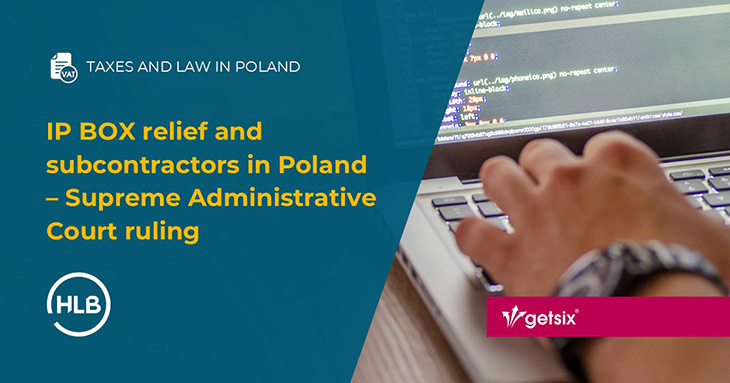IP BOX relief and subcontractors in Poland – Supreme Administrative Court ruling
Does a company that designs solutions and manages work on a system, but outsources coding to a B2B programmer, still conduct R&D activities – and is it entitled to a 5% IP Box relief – preferential PIT and CIT taxation of income from eligible intellectual property rights (e.g. copyrighted computer software)? The Supreme Administrative Court’s ruling, ref. II FSK 61/25, confirms that R&D is determined by the taxpayer’s role as the author of the concept and coordinator, as well as by their ownership of the property rights to the results; what counts is the creative development of the software, not who physically writes the code.
In operational terms, the ruling strengthens taxpayers cooperating with subcontractors: separate IP Box records are required, development work must be separated from maintenance work, and costs must be correctly included in the nexus ratio.
Background to the case – who ‘creates’ in a model with a subcontractor
The interpretation of the Director of the National Revenue Information Service (KIS) of 31 May 2024 concerned a company that had been developing its own computer programme ‘R’ for years. The company designed the directions of development and new modules of the system, and commissioned a programmer to implement them in a B2B model, with full transfer of property copyrights to the results. The software was commercialised (licences/SaaS), and the company bore the costs of producing and maintaining the solution. However, the authority decided that the company was ‘purchasing services’ and therefore not conducting R&D, and consequently considered questions about the IP Box relief (including the 5% IP Box, the nexus ratio and IP Box records) to be irrelevant.
The Provincial Administrative Court in Białystok (30 October 2024, I SA/Bk 272/24) overturned the interpretation, indicating that R&D is determined by the creative role of the taxpayer (concept, supervision, coordination) and ownership of the results, and that the development of acquired IP may constitute development work. The Supreme Administrative Court, in its final judgment of 3 June 2025 (II FSK 61/25), dismissed the cassation appeal of the National Tax Information Service, confirming that the use of subcontractors does not exclude the IP Box relief, and that the authority should address the substantive issues of qualified intellectual property rights, income from qualified IP, calculation of the nexus ratio and keeping IP Box records.
The grounds for the judgment clearly state that:
- Outsourcing (B2B subcontractors) does not exclude IP Box or R&D relief.
- The decisive factors are the taxpayer’s role (concept, coordination) and copyright to the results.
- The development of acquired software constitutes development work (qualified IP).
- Separate IP Box records and correct calculation of the nexus ratio are required.
- The costs of unrelated services increase the portion qualified in the nexus.
- The authority is required to address the 5% and the inclusion of costs in the nexus.
The most common mistakes in IP Box relief and how to avoid them
The most common risks associated with IP Box relief are mainly errors in documentation, problems with cost qualification and the presentation of work, which may lead to the loss of the right to relief or a tax audit. The most significant risk is improper record keeping, as detailed, separate documentation of revenues, costs and income related to eligible intellectual property rights is required. Failure to keep such records or errors in them may result in the need to pay back taxes and penalties.
Approaches to limiting tax uncertainty include:
- Keeping detailed and compliant accounting records, in which all financial operations related to IP Box are separated.
- Using professional accounting services to help prepare, correct, and maintain proper documentation.
- Obtaining positive individual interpretations from tax authorities confirming the correct application of the relief.
- Accurate classification of activities as research and development and incurring appropriate eligible costs to produce eligible IP.
- Calculating and monitoring the nexus ratio, which is key to correctly determining the income covered by the IP Box relief.
- These measures minimise the risk of tax uncertainties and audits and help to ensure the correct application of the preferential 5% tax rate instead of the standard tax rates.
IP Box in the B2B model – practical consequences for technology companies
The ruling clarifies the practice: cooperation with B2B subcontractors does not conflict with IP Box, as long as the company conducts development work on proprietary computer software, manages the direction of the project and has rights to the results. In practice, this is a green light for SaaS models and software houses that also develop acquired solutions – provided that IP Box records are kept accurately and the nexus ratio is calculated correctly.
IP Box in the B2B model – recommended steps
It is recommended to conduct a brief review of IP Box settlements, including: verification of R&D criteria (creativity, systematicity), assessment of the full transfer of rights in B2B agreements, organisation of records ‘per product/module’ and classification of costs into letters a/b/c/d with calculation of the nexus ratio. It is worth standardising contract templates (fields of exploitation, derivative rights), describing methods of allocating common costs and supplementing the design and technical documentation.
The Supreme Administrative Court ruling (II FSK 61/25) confirms that outsourcing programming work does not exclude IP Box if the entity defines the concept, coordinates the work and has the rights to the results. The security of preferences is mainly determined by: separate IP Box records, separation of development and maintenance work, and a correctly determined nexus ratio. For IT and SaaS companies, this means a real possibility of maintaining 5% for income from eligible IP – provided that the described evidentiary and contractual standards are maintained.
If you have any questions regarding this topic or if you are in need for any additional information – please do not hesitate to contact us:
CUSTOMER RELATIONSHIPS DEPARTMENT

ELŻBIETA NARON
Head of Customer Relationships
Department / Senior Manager
getsix® Group
***





